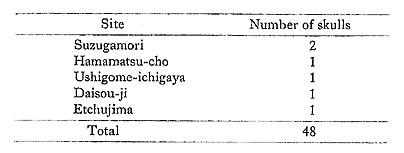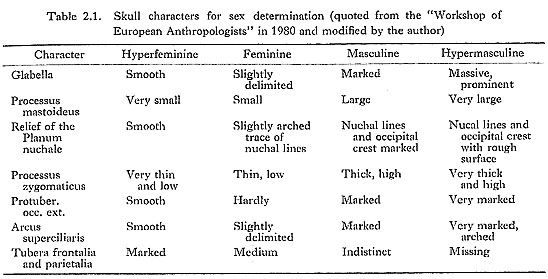CHAPTER 2
Materials
1. Skeletal Remains of the Edo PeriodThe materials used in the present study are from the six cranial series listed below.
All cranial series were excavated from different sites within Tokyo, and they were identified as belonging to the Edo period by their byburials, by stratigraphical study, and by archaeological investigations (SUZUKI (H) et al., 1957; KAWAGOE, 1957; and KOIZUMI, 1979). Outline of the six main sites1) Unko-in site: The Unko-in temple, established in 1611, is situated in Fuka-gawa, Koto-ku, Tokyo. In 1955, when drainage work on the sewage system of the neighborhood adjacent to the temple was being done, numerous human skeletal remains from the Edo period were found and dug up. These large numbers of skeletons were studied and reported on by SUZUKI (H) et al. in 1957 and 1967. They are considered to be those of common people who died during the middle and late Edo period. 2) Higashi-ueno site: About half of the Higashi-ueno series (59/107) was excavated from the Higashi-ueno site in Taito-ku, Tokyo, where many temples and shrines were located during the latter half of the Edo period. The other half was excavated from a number of different sites in Tokyo, as listed below:
Thus, the Higashi-ueno series, which was made up of the "real" Higashi-ueno series and another small series, should be considered on the whole as a "hetrogeneous" or "mixed" cranial series. In the strict sense, this "heterogeneous" series does not necessarily have the same significance as the other "homogeneous" cranial series. In this context, a part of the examination of the statistical and palaeoepidemiological analysis will exclude this heterogeneous cranial series in order to make an accurate comparison of the homogeneous cranial series. 3) Joshin-ji site: Joshin-ji temple, established in 1658, is said to have been a large Buddhist temple that included eight small temples within its sacred grounds during the Edo period. Joshin-ji temple is located in the same Fukagawa area as the above-mentioned Unko-in temple. The skeletal remains consisted of about 160 individuals excavated in 1955, and reported on by SUZUKI (H) et al. in 1957 and 1967. The skeletons collected were also those of common people or townspeople of Edo who are thought to have died during the middle and late Edo period. 4) Hitotsu-bashi site: The skeletal remains of the Hitotsu-bashi cranial series were excavated from the grounds of Hitotsu-bashi High School at Kanda, Chiyoda-ku, Tokyo, in 1975, while the school building was under reconstruction. Many of the human skeletal remains were packed in coffins with chinaware, old coins, and many other byburials. They are presently under anthropological study by MORIMOTO and his colleagues at the School of Medicine of St. Marianna University. According to the preliminary excavation, report published in 1976, the human skeletal remains of about 170 adults were unearthed from the lowest layer (the fifth layer), which was regarded to have been formed during the early and middle Edo period. KOIZUMI (1979) suggested that the ground which yielded many of these skeletal and cultural remains corresponded to the graveyard of En'o-in temple which had existed in that area during the early Edo period. Thus, the skeletons are probably those of citizens of the early Edo period who died before Meireki's Great Fire of Edo in 1657. 5) Muen-zaka site: The skeletal remains called the Muen-zaka cranial series consist of about 200 individuals excavated from Muen-zaka, Yushima, Tokyo, in 1955. The anthropological data of 219 isolated skulls with the historical outlines of Muen-zaka were published by KAWAGOE in 1957 and MORITA and KAWAGOE in 1960. It is said that during the Edo period the Muen-ji temple was situated in the Muen-zaka area. KAWAGOE stated that those buried within the temple grounds may have consist of a large number of the higher official warrior class of the TOKUGAWA government (Hatamoto-samurai). It is said that many buried skeletal remains, consisting chiefly of islolated skulls, were left behind in the Muen-zaka area when many of the remains were removed from the grounds of the Muen-ji temple and reburied in Zoshigaya cemetary during the late Meiji period. 6) Kochi-ryu and Kochi-sha site: The "Kochi-ryu" and the "Kochi-sha" sites were located very near each other. Kochi-ryu and Kochi-sha were the names given respectively to the subway construction sites of the towns of Ryusen-ji and Shimo-kuruma-zaka. Both cranial series were found very near the field of construction for a subway in Taito-ku, Tokyo, in 1959, and were excavated during the same period by KAWAGOE of the Jikei University School of Medicine. The temple from which the materials of both the Kochi-ryu and the Kochi-sha series were taken has never been identified due to the fact that there were many shrines and temples, such as Fumon-in, Josho-in, and Keisei-in, in both areas during the middle and late Edo period. Although detailed anthropological studies have not been published yet on either cranial series, these two series can be considered as one based on the information and records of KAWAGOE, KAWAGOE, for instance, registered the skulls of these two series with continuous numbers and arranged them on the same shelf in his laboratory. Therefore, in the present investigation, the author will handle these two series, totaling 187 isolated skulls, as if they were a single series. After exclusion of the immature and severely damaged skulls, the materials finally totaled 923 adult skulls. The sexing and age estimations on all of them were made according to the manner corresponding to general anthropological inspections (see STEWART, 1948; HANIHARA, 1952; BROTHWELL, 1972; KROGMANN, 1973; KOBAYASHI, 1967; and HANIHARA and SUZUKI, 1978). In regard to sex determination, the "Recom mendations for age and sex diagnosis of skeleton" adopted in the Workshop of European Anthropologists in 1980 (Table 2.1) was used.
Since in the present study the author deals mainly with isolated skulls of the Edo period, it proved somewhat difficult to estimate the age of each individual using the skull alone. Nevertheless, a few important points should be observed in estimating the age of a skull. 1) Morphology of the three main suture closures of the skull. The endocranial suture closure is a more reliable age indicator than the ectocranial (KOIZUMI, 1982). Skulls showing complete obliteration of the endocranial sutures are generally classified Into the "Mature and Senile" age group. 2) The ossification of the synchondrosis spheno-occipitalis in the basal part of the skull. The fusion of this spheno-occipital junction usually begins at about the 17th year, and both bones unite completely between the ages of 20 and 23 (BROTHWELL, 1972), This ossification delineates the border between "Young" and "Adult" age groups in this study. 3) The condition of suture closure in the orbits. Among the bones which compose the eye socket are several small sutures whose condition of closure changes continuously with age, particularly during the mature period. Close investigation of these suture closures in the orbits has been made by KAMIJO (1979). In this study, the condition of these suture closures has been considered as a valuable indicator for separating the materials into "Adult" and "Mature and Senile" age groups, i.e., the later age group usually shows an almost complete obliteration in the frontethimoidal, sphenoethimoidal, and sphenofrontal sutures. 4) Dental attrition which has been used for a long time as an. age indicator was considered as the only reference data for the estimation of age in this study, because there were many cases showing pathological changes probably due to pyorrhoea alveo-laris or dental caries in the teeth or alveolar region. In conclusion, the skulls of the Edo period used here were roughly classified into three age groups according to some of the osteological age indicators mentioned above.
The skulls of "Young" age group as defined here show a clear opening of the three main endocranial sutures, incomplete ossification of the spheno-occipital synchondrosis. and little attrition of the teeth. The skulls estimated as belonging to "Mature & Senile" age group show complete obliteration of the three main suture closures, considerable fusions among the intraorbital sutures, and apparent dental wear with bone resorption and atrophy in the alveolar region. The results of the sex and age estimations on the 923 individual skulls of the Edo period used in the present study are given in Table 2.2.
2. Other Materials (Jomon and Recent Ainu Skeletal Remains)The other materials in the present study consist of a fragment of tibia from the Jomon skeletal remains and two complete skeletons of recent Ainu. The former was excavated from Todoroki shell mound in Kumamoto Prefecture in 1920 and is now stored in the Department of Physical Anthropology and Prehistory, the University Museum, The University of Tokyo; the latter were collected by KOGANEI in 1888 from Hokkaido island, northern Japan, and are now preserved in the Department of Anatomy, the University Museum, The University of Tokyo. An anthropological description of the Ainu skeletal remains was written by KOGANEI (1894) and includes an excellent example of typical osseous syphilis diagnosed by KOGANEI, which is redescribed in detail as a reference source for basic and/or comparative data in the present study. |



